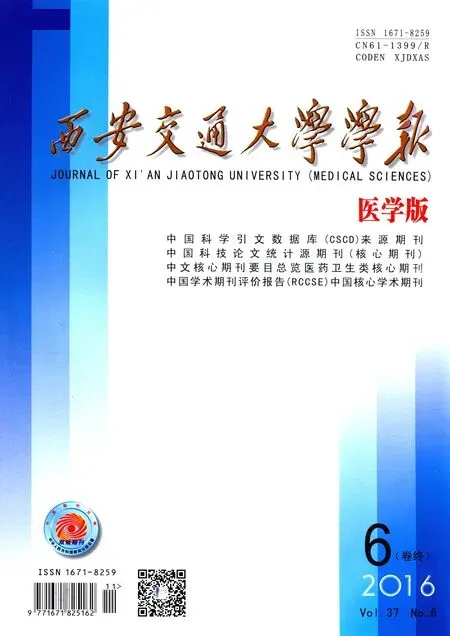分子印迹技术及其在药物分离与分析中的应用
2016-12-08罗智敏郭鹏琦
傅 强,罗智敏,郭鹏琦
(西安交通大学医学部药学院药物分析学系,陕西西安 710061)
◇专家述评◇

分子印迹技术及其在药物分离与分析中的应用
傅 强,罗智敏,郭鹏琦
(西安交通大学医学部药学院药物分析学系,陕西西安 710061)
复杂体系微量药物和药物相关物质的分离与分析是药学研究领域的共性问题。建立高灵敏度、高选择性、高速度、自动化、连续化、智能化的分析技术是药物分析学科发展的重要方向。新方法的建立对于进一步了解生命过程和药物的作用、保障药品质量、提高药品疗效发挥了积极的推动作用。近年来发展起来的分子印迹技术具有构效预定性、识别特异性、长期稳定性和广泛适用性等特点,得到研究者的广泛关注。本文简述分子印迹技术的原理和制备方法,综述了分子印迹技术在手性药物分析、体内药物分析、中药活性成分和生物大分子的分离与分析等中的应用,并对其面临的问题及应用前景进行了展望。
分子印迹技术;药物分离;药物分析
药物与生命体的相互作用,本质上是物质间的相互作用。灵敏度高、特异性强的分析技术对于进一步了解生命过程和药物的作用、保障药品质量、提高药品疗效发挥了积极的推动作用。分子印迹技术(molecular imprinting technology, MIT)是一种高选择性、特异性的分离和分析技术,这种技术的思想源于抗原-抗体专一性识别。基于分子识别的聚合物材料——分子印迹聚合物具有构效预定性、识别特异性、长期稳定性和广泛适用性等特点,且具有抗恶劣环境能力强、稳定性好、使用寿命长等优点,使得MIT在诸多领域均展现了良好的应用前景。
1 原理与聚合物制备
1.1 基本原理 分子印迹的概念是由POLYAKOV 1931年提出,MOSBACH研究组在Nature上发表了茶碱和安定分子印迹聚合物的报道,引起了人们对MIT的极大关注,使得MIT得到了迅速的发展[1-2]。
MIT是一个为目标分子合成人工抗体的过程。分子印迹聚合物(molecularly imprinted polymers, MIPs)的合成过程是以目标分子为模板(template),将具有结构互补的功能单体(functional monomers)与模板分子结合后,使用交联剂(cross linker)聚合在一起,然后将目标分子去除,便会留下一系列大小、形状与目标分子相匹配的结合位点。MIPs不仅具有类似天然抗体识别的特异性、高选择性和高结合能力等特点,还具有更好的稳定性、制备过程简单并可重复使用等优点[3]。
1.2 MIPs的制备 MIPs的制备过程如图1所示。根据模板分子与功能单体相互作用的原理不同,传统MIPs的制备方法主要包括预组装法、自组装法、结合法和金属螯合法[1]。

图1 MIPs制备过程示意图Fig.1 The preparation process of molecularly imprinted polymers
然而,传统的MIPs制备方法均为不可控的自由基聚合法,这就导致MIPs存在非特异性的结合位点、结合位点分布不均一以及聚合层厚度不均一等问题。为了克服这些缺点,近几年研究人员将可控活性自由基聚合法引入到MIT中,该法通过控制溶液中参与反应的自由基的钝化,从而控制整个反应的速度和进程[4]。可控活性自由基聚合法主要包括以下几种:
1.2.1 可逆加成-断裂链转移聚合法(reversible addition fragmentation chain transfer polymerization, RAFT) 该法制备过程中需要有可逆加成序列的存在,通过控制该序列中活跃链和休眠链间双硫酯键的转移来控制聚合的进程。该法所得聚合物的分子量分布、分子大小和分子结构都可以实现有效控制[5]。
1.2.2 引发-转移-终止聚合法(initiation and transfer termination polymerization, ITTP) 该法是利用二硫代氨基甲酸盐分裂成初始化的烷基以及稳定的第二种自由基过程来制备。由于第二种自由基无法引发新的聚合链,当向该反应供给热量或者减少紫外辐射时两种自由基会重组而停止链增长,之后再进行下一次引发聚合,因此会在一定程度上实现了在线控制[6]。
1.2.3 原子转移自由基聚合法(atom transfer radical polymerization, ATRP) 该法是通过可逆的氧化还原反应产生多种活性基团,经金属离子/配体复合物所催化,该催化剂则可以被从休眠态到活化态所转移的卤素原子所氧化,从而使复合物到达一个高氧化状态[7]。
1.2.4 氮氧自由基聚合法(nitroxide mediated polymerization, NMP) 该法是一个热可逆终止反应,烷氧基胺C-ON键的均裂会促使该反应的发生,从而烷基和氮氧自由基被激活,可以通过控制自由基产生的量来控制整个反应的进程[8]。
2 MIPs在药物分离与分析中的应用
与常规的分离或分析用的色谱固定相比较,MIPs的突出特点是对目标分子具有高度的选择性,同时还具有良好的物理化学稳定性,能够耐受高温、高压、酸碱、有机溶剂等,容易保存、制备简单、易于实现规模化制备,因而得到比较广泛的应用。MIPs在药物分离与分析中主要被应用于手性药物分析、体内药物分析、中药活性成分分离与分析以及药物杂质分离与分析等几个方面。
2.1 手性药物分析 手性药物(chiral drug)的拆分一直是制药工业、临床药物分析和环境检测领域的研究热点。目前世界临床使用的合成药物中,手性药物占40%,且87%以上的手性药物是以外消旋体的形式出售[9]。随着对手性药物研究的不断深入,人们已经发现手性药物的药效学、药动学和毒理学可表现出质和量的区别,这就对分离手性药物的技术提出了新的要求。尽管目前已有手性合成、酶拆分以及其它的分离技术,但MIPs在分离对映体方面有独到之处,而且MIPs作为色谱固定相进行手性拆分也是MIPs早期的研究重点。目前已成功分离的手性药物见表1。
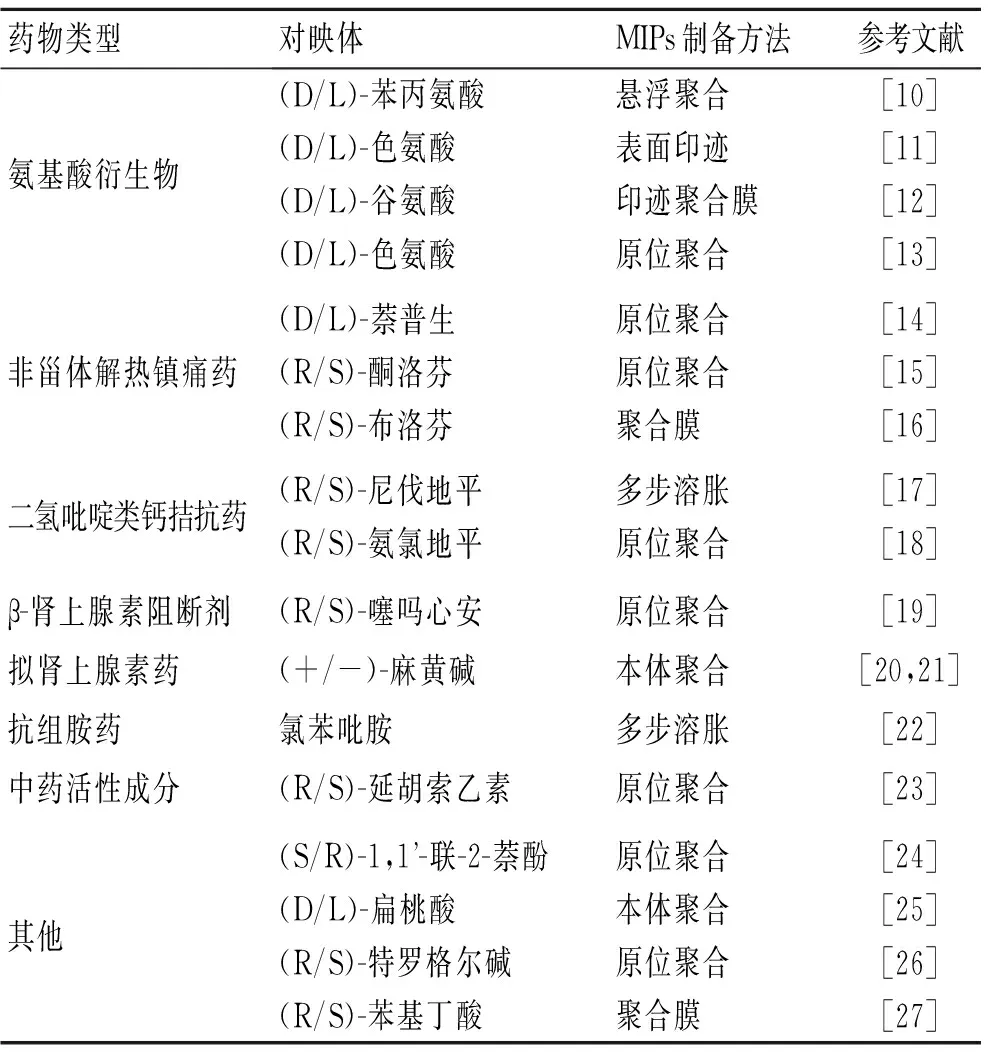
表1 MIPs用于对手性药物的分析Tab.1 The application of MIPs for the analysis of chiral drugs
尽管MIPs作为手性固定相已经研究二十余年,但其仍未投入商业使用,原因可能是由于MIPs手性固定相仅能针对特定手性药物进行分离,广谱适用性较差;另外,缺乏高纯度的光学异构体作为模板,也限制了其应用。
2.2 体内药物分析 体液成份复杂,干扰物质多,而待测药物浓度一般都很低。如何方便、快捷地对样品进行预处理,将少量的目标药物从大量复杂的生物基质中分离出来,以便准确定性、定量,是体内药物分析面临的首要问题[28]。近年来,随着药物分析技术的不断提高,生物样品预处理技术得到迅速发展,并克服了传统萃取方式回收率低、繁琐费时、溶剂毒性大、易乳化等不足。其中,固相萃取技术(solid phase extraction, SPE)因其对目标物具有回收率高、有机溶剂用量少、无相分离操作、能处理微量样品以及易于自动化等优点而被广泛和普遍应用的样品前处理方法[29]。然而,由于常规固相萃取吸附材料(如硅胶或C18材料等)与目标分析物之间的作用是非特异性的,常常因萃取介质对目标物的选择性较差的原因,在吸附目标物的同时也引入了部分基质和干扰物,使得对目标物的分析受到干扰[30]。而分子印迹固相萃取是以MIPs为萃取介质的固相萃取技术,MIPs具有从复杂样品中特异地吸附目标分子的能力,这一性质使得MIPs非常适合作为SPE萃取介质实现对复杂样品中的目标物选择性的分离和富集[31]。
自1994年SELLERGREN等[32]以戊咪为模板分子制备了MIPs并将其作为固相萃取吸附剂用于对尿液中戊咪的分离后,将MIPs与SPE结合用于对体内药物分析的研究呈现出迅速发展。分子印迹-固相萃取(molecularly imprinted-solid phase extraction, MISPE)可用于对各种复杂样品中目标物的分离、纯化和浓缩,涉及到的生物样品包括各种体液、组织和排泄物等[33],被检测过化合物多为药物及其代谢物、毒物或其他有害物质等(表2)。
2.3 环境样品中药物的分离与分析 鉴于环境样品中目标物的浓度低、组分复杂且易变化,因而其检测对技术的要求越来越高。MIPs用作固相萃取剂可克服环境样品体系复杂的预处理手续,为这些样品的采集、富集和分析提供极大的方便,尤其在痕量分析中发挥重要作用,毫摩尔水平下的痕量物质经这一方法预富集处理后,在色谱中则易于检出(表3)。随着MIT的不断深入和应用领域的不断拓展,MIT在环境领域定会有更广阔的应用前景。
2.4 中药活性成分的分离与分析 中药是一个复杂的、结构多样性的天然组合化学库,其所含的化合物结构类型多样、量悬殊且许多成分未知,导致对中药活性成分分离和分析的难度较大[76]。目前分离和分析中药活性成分主要依赖于硅胶柱色谱(silica gel column chromatography)、大孔吸附树脂柱色谱(macroporous adsorption resin column chromatography)、聚酰胺柱色谱(polyamide column chromatography)、凝胶柱色谱(gel column choromatography)、高速逆流色谱(high-speed countercurrent chromatography)、制备型高效液相色谱(preparative high performance liquid chromatography)等技术,为了更好地对活性成分进行分离和分析,常需经多种溶剂萃取和反复柱色谱,不仅溶剂消耗量大、环境污染严重,而且效率和收率也低[77]。基于MIT制备的MIPs具有亲和性强和选择性高、抗恶劣环境能力强、稳定性好、使用寿命长、应用范围广等特点[78],而且MIPs具有其他分离材料所不具备的特异性和选择性,MIT将在中药目标成分的分离和分析中具有广阔的应用前景。目前用MIT研究的中药成分有黄酮类、多元酚类、生物碱类、甾体类、香豆素类和木脂素类等(表4),均取得了良好的效果。
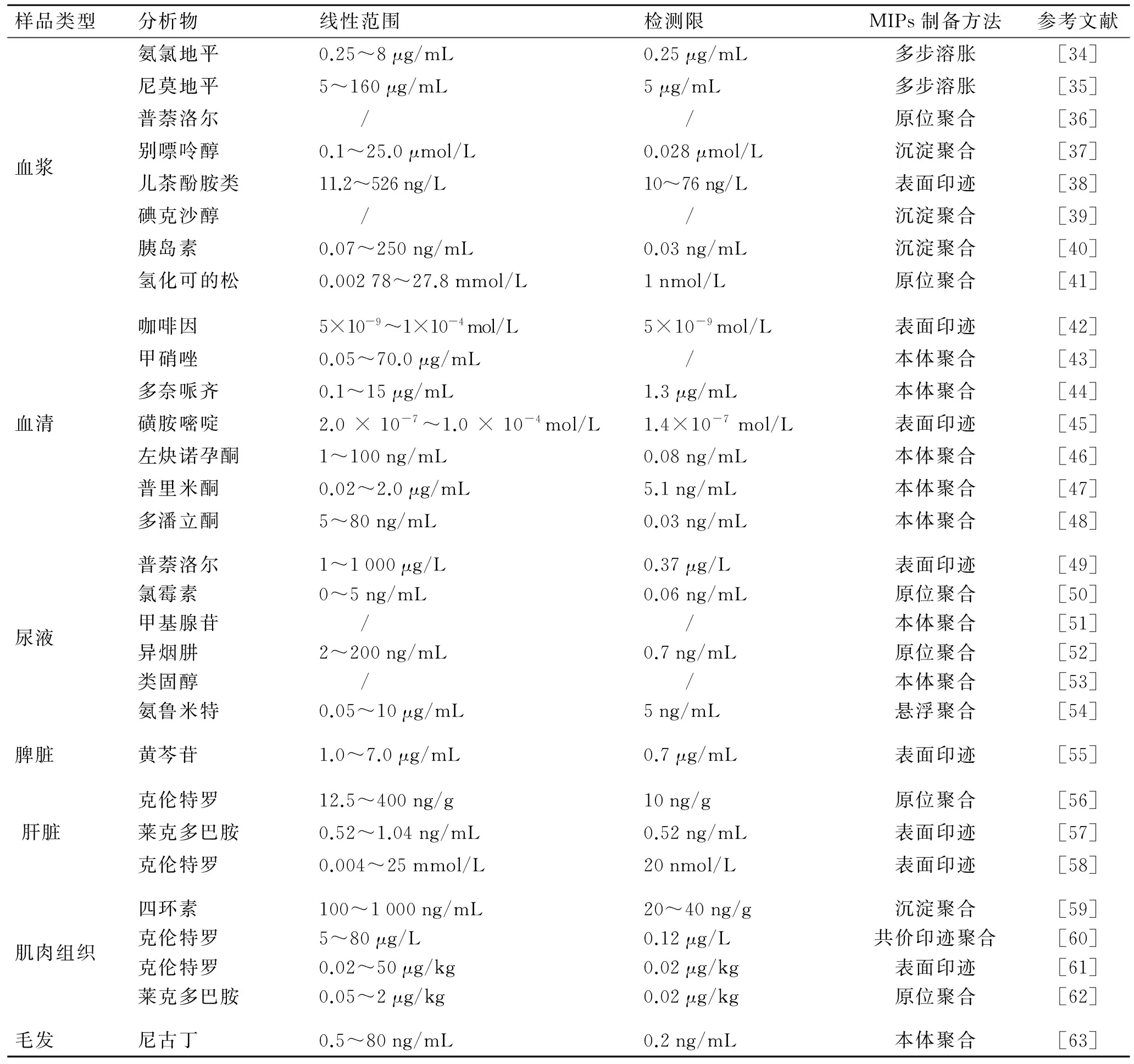
表2 MIPs用于对体内样品中目标物的分析Tab.2 The application of MIPs for the analysis of targets in biological samples
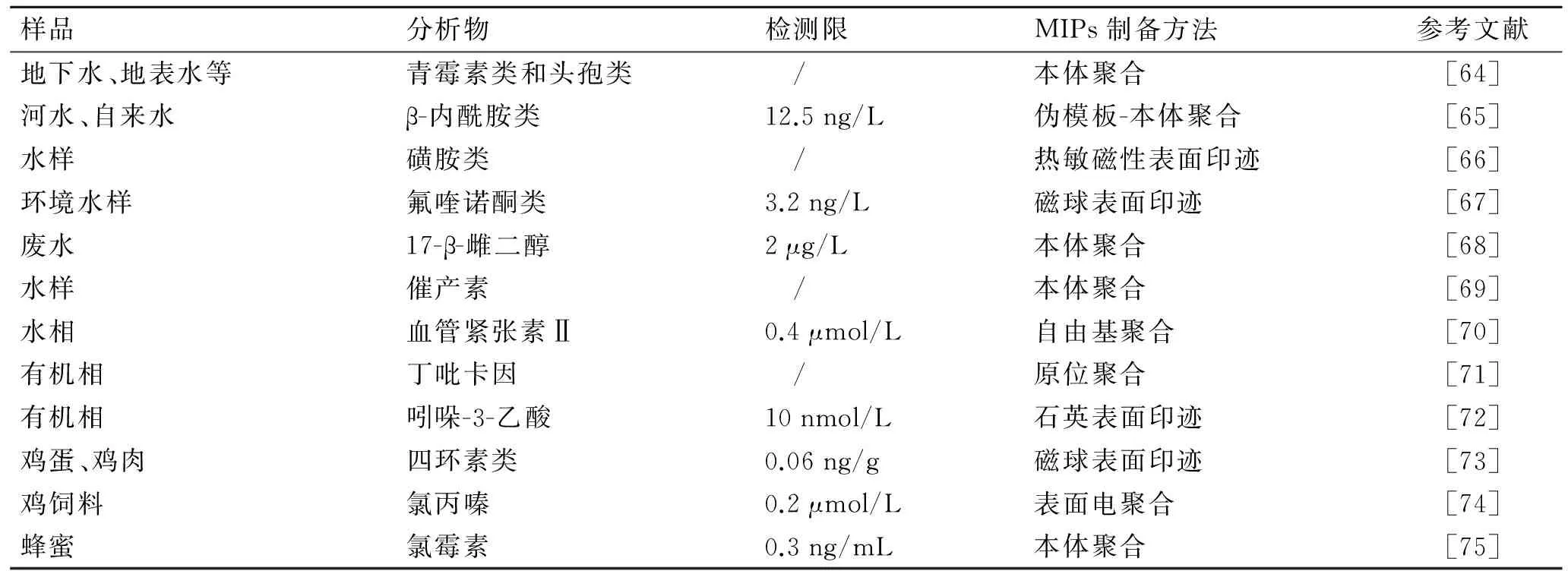
表3 MIPs用于对环境样品中药物的分离与分析Tab.3 The application of MIPs for the analysis of different types of drugs
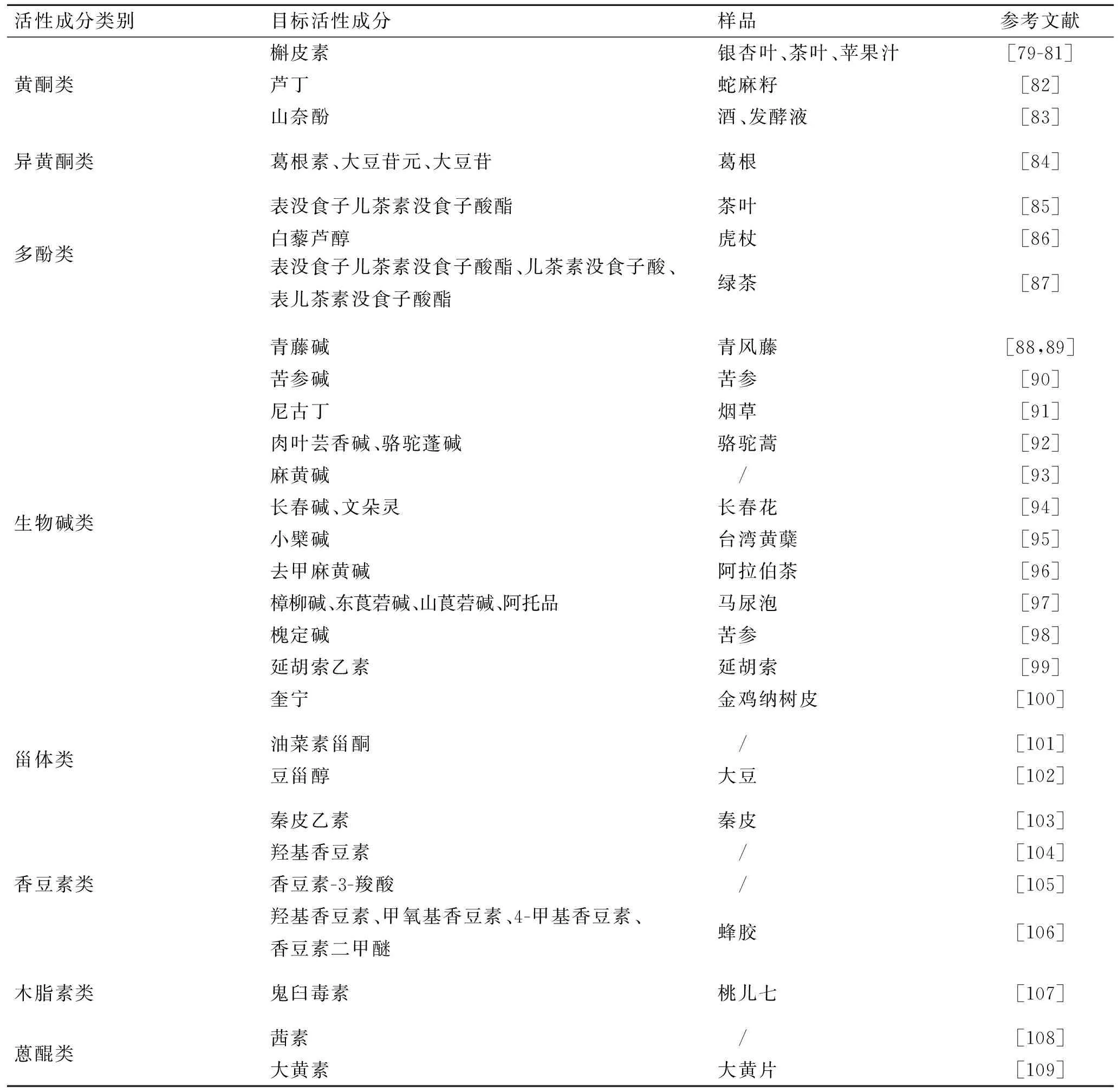
表4 MIPs用于中药活性成分的分离与分析Tab.4 The application of MIPs for the separation and analysis of the active ingredients in traditional Chinese medicines
然而,MIPs在中药活性成分分离与分析中的应用也有一定的局限性:①有些模板十分昂贵或难于获取,且模板需用量较大,导致成本过高;②目前制备相对分子质量较大的目标物的MIPs还有一定的困难,需进一步开发中药活性成分的模板;③MIPs的吸附容量受外界条件影响较大、较不稳定,因此对目标物的回收率常出现波动;④MIPs对模板的结构类似物也会有一定的交叉识别作用,因此吸附物很难保证是单一模板化合物,吸附后还需进一步纯化等。
2.5 药物杂质的分离与分析 药物杂质控制是药品质量研究中的一项重要内容。药物中的杂质含量低、来源广泛、结构类型多且与主成分类似,必须选择合适的分析技术进行研究[110]。MIPs的高选择性、高强度、高耐用性及可重复使用等诸多优点使得MIT在药物杂质分离和分析中也显示出良好的应用前景。
NAJAFI等[111]采用MIPs-电位传感器分析吡罗昔康中的杂质2-氨基吡啶(2-AP),结果显示,该传感器对2-AP有高度识别性;HASHEMI等[112-113]制备的MIPs分别用于从盐酸苯海拉明原料药和氟伏沙明原料药中特异识别具有潜在遗传毒性的杂质;BALAMURUGAN等[114]合成了分子印迹液相色谱柱用于检测伪麻黄碱硫酸盐对映体杂质,结果显示,两个对映体的分离度不低于2,拖尾因子小于3.5,分离效果良好;LUO等[115-116]采用表面分子印迹法制备了MIPs,该MIPs可以从青霉素原料药中特异识别具潜在致敏性的青霉噻唑酸;DU等[117]采用溶胶凝胶法制备的MIPs可从氯唑西林钠原料药中特异识别氯唑西林噻唑酸杂质;SZÉKELY等[118]制备的MIPs结合有机溶剂纳滤,可实现从药物活性组分中对具有遗传毒性的1,3-diisopropylurea的特异识别和分离。因此,MIT的不断发展为药物杂质的分离和分析提供了新的方法。
2.6 生物大分子的分离与分析 以蛋白质、DNA、多糖等生物大分子为模板的MIT是一个崭新而且富有挑战性的研究。MIT利用仿生原理进行分子识别,它具有的高特异性、高亲和性以及良好的稳定性都为其在生物大分子的分析应用奠定了基础,已经成功被印迹的生物大分子具体见表5。
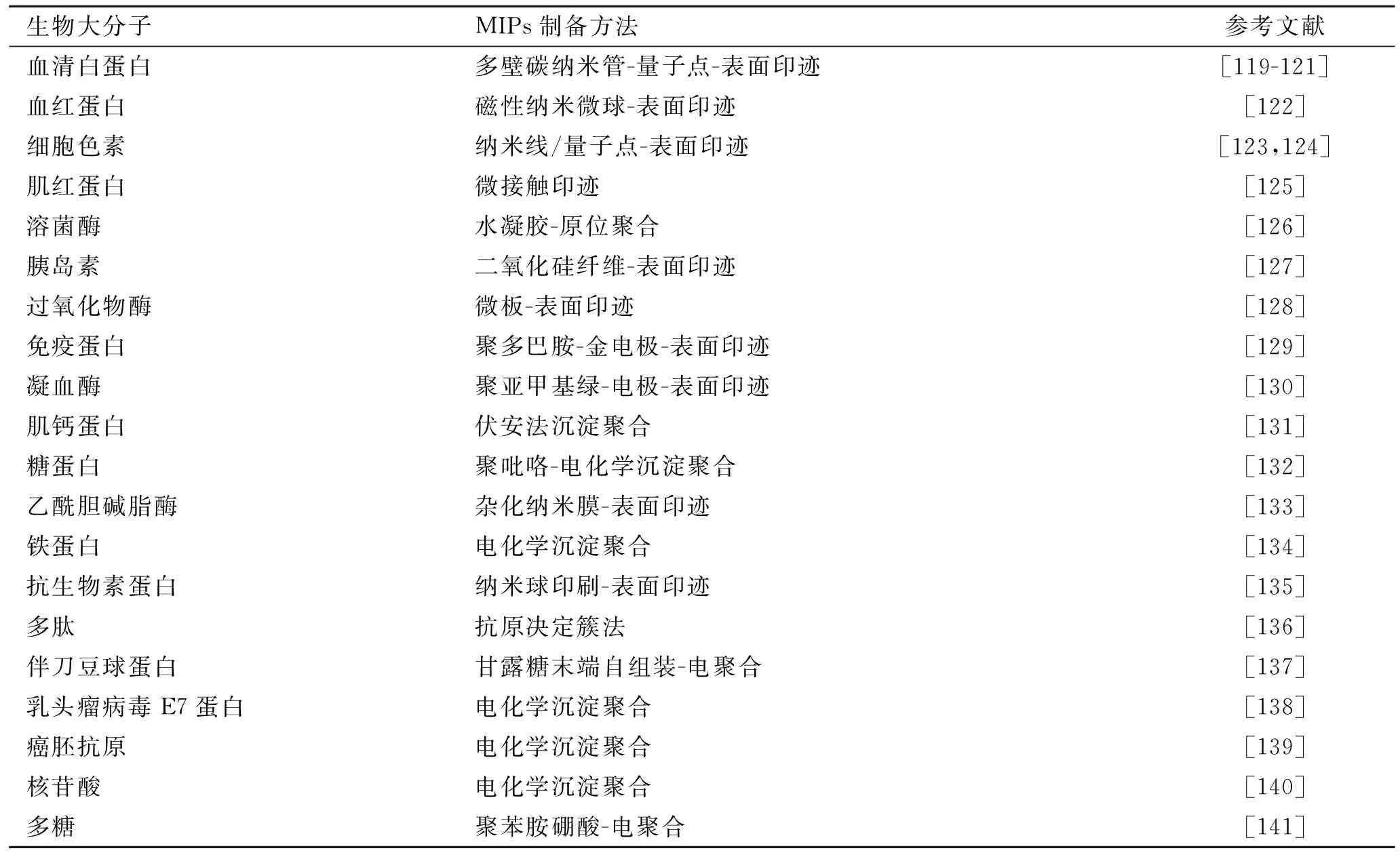
表5 MIPs用于生物大分子的分离与分析Tab.5 The application of MIPs for the separation and analysis of biomacromolecules
目前,分子印迹作为一种新型的技术用于生物大分子印迹也有许多局限性[118,142]:①生物大分子和聚合物单体官能团间的相互作用缺乏系统研究,在识别过程中是孔穴的三维空间结构还是功能基团或其他方面起主导作用还无共识;②目前还没有令人满意的聚合方法以得到高吸附量的MIPs,这就使得MIT远远不能满足实际应用的需要;③尚未找到合适的方法洗脱蛋白质印迹分子,活性蛋白质很难得到回收利用。
3 展 望
近年来,随着MIT的不断发展,其作为一种方便、有效、操作简单的分离技术,已经被广泛应用于生物样品预处理、体内微量药物和代谢产物的检测、毒物和药物滥用分析、食品中药物的非法添加和残留分析、原料药及制剂中有关物质的富集和检查等方面;更由于MIT具有易于产业化等优点,越来越受到广大研究者的重视,在药学领域中也发挥了越来越大的作用,并显示出独特的优势和良好的应用前景。
然而,作为一种新型的分离、富集手段,MIT自身还存在一定的问题:①MIPs与目标物识别的作用机制研究相对肤浅;②功能单体、交联剂和聚合方法的选择有很大局限性;③该技术在诸多的应用研究较多,但目前商业化的步伐缓慢,如何加速MIT的商业化是研究者需要关注的问题;④MIPs分离和富集目标物的过程易于受到外界诸多因素的影响,如何提高其重复性的问题亟待解决;⑤尽管对生物大分子的印迹研究已取得了一定的进展,但所采用的方法多数普适性较差,方法本身也不够成熟,实验结果的重现性不好,制备过程较烦琐,迄今研究过的对象也比较少;⑥由于聚合条件的限制,MIPs在水相条件下聚合以及在水相条件下应用的研究相对滞后,而且其在水环境下的识别机制也不甚清楚。因此,MIT还需要随着新型材料的应用和新技术的推进从而进一步发展和完善。
尽管MIT具有上述种种局限性,但由于其具备很高的选择性以及优良的理化特性,其必然会随着技术本身的不断发展和应用的逐渐增多,将在药物的分离与分析领域发挥越来越大的作用。
[1] 傅强,曾爱国,杜玮,等. 分子印迹技术与药物分析[M]. 西安:西安交通大学出版社. 2014, 1-2.
[2] VLATAKIS G, ANDERSSON LI, MULLER R, et al. Drug assay using antibody mimics made by molecular imprinting[J]. Nature, 1993, 361(6413):645-647.
[3] SCHIRHAGL R. Bioapplications for molecularly imprinted polymers[J]. Anal Chem, 2013, 86(1):250-261.
[4] BOMPART M, HAUPT K. Molecularly imprinted polymers and controlled/living radical polymerization[J]. Aust J Chem, 2009, 62(52):751-761.
[5] HALHALLI MR, SCHILLINGER E, AURELIANO CSA, et al. Thin walled imprinted polymer beads featuring both uniform and accessible binding sites[J]. Chem Mater, 2012, 24(15):2909-2919.
[6] SALIAN VD, BYRNE ME. Living radical polymerization and molecular imprinting: Improving polymer morphology in imprinted polymers[J]. Macromol Mater Eng, 2013, 298(4):379-390.
[7] KIM YH, FORD WT, MOUREY TH. Branched poly(styrene-b-tert-butyl acrylate) and poly(styrene-b-acrylic acid) by ATRP from a dendritic poly(propylene imine) (NH2)64core[J]. J Polym Sci Pol Chem, 2007, 45(20):4623-4634.
[8] HAWKER CJ, BOSMAN AW, HARTH E. New polymer synthesis by nitroxide mediated living radical polymerizations[J]. Chem Rev, 2001, 33(15):3661-3688.
[9] 马娟娟,王新龙,杨春杰. 分子印迹聚合物材料在手性药物分离和药物检测中的应用[J]. 化工时刊, 2004, 18(1):5-8.
[10] MAYES AG, MOSBACH K. Molecularly imprinted polymer beads: suspension polymerization using a liquid perfluorocarbon as the dispersing phase[J]. Anal Chem, 1996, 68(21):3769-3774.
[11] QU P, LEI J, OUYANG R, et al. Enantioseparation and amperometric detection of chiral compounds by in situ molecular imprinting on the microchannel wall[J]. Anal Chem, 2009, 81(23):9651-6.
[12] ZHU X, ZHU Q. Molecular imprinted Nylon-6 stir bar as a novel extraction technique for enantioseparation of amino acids[J]. J Appl Polym Sci, 2008, 109(4):2665-2670.
[13] MENG Z, ZHOU L, WANG J, et al. Molecule imprinting chiral stationary phase[J]. Biomed Chromatogr, 1999, 13(6):389-93.
[14] HUANGFU F, WANG B, SHAN J, et al. Enantioselective analysis of naproxen using chiral molecular imprinting polymers based thin-layer chromatography[J]. E-Polymers, 2013, 13(1):180-188.
[15] LEI, J, TAN T. Chiral separation of racemic drugs using molecular imprinting[J]. Prog Nat Sci, 2002, 12(12):900-903.
[16] 赵潇,秦培勇. 布洛芬手性拆分分子印迹复合膜的制备与表征[J]. 北京化工大学学报(自然科学版), 2013, 40(1):5-9.
[17] FU Q, SANBE H, KAGAWA C, et al. Uniformly sized molecularly imprinted polymer for (S)-nilvadipine. Comparison of chiral recognition ability with HPLC chiral stationary phases based on a protein[J]. Anal Chem, 2003, 75(2):191-198.
[18] AMUT E, FU Q, FANG Q, et al. In situ polymerization preparation of chiral molecular imprinting polymers monolithic column for amlodipine and its recognition properties study[J]. J Polym Res, 2009, 17(3):401-409.
[19] FISCHER L, MUELLER R, EKBERG B, et al. Direct enantioseparation of. beta.-adrenergic blockers using a chiral stationary phase prepared by molecular imprinting[J]. J Am Chem Soc, 1991, 113(24):9358-9360.
[20] DUARTE M, BILLING J, YILMAZ E. Solvent-free synthesis of chiral molecularly imprinted polymers: Porosity control using a nano-sized solid porogen[J]. J Appl Polym Sci, 2016, 133(41):44104-44108.
[21] RAMSTROM O, YU C, MOSBACH K. Chiral recognition in adrenergic receptor binding mimics prepared by molecular imprinting[J]. J Mol Recognit, 1996, 9(5-6):691-696.
[22] HAGINAKA J, KAGAWA C. Uniformly sized molecularly imprinted polymer for d-chlorpheniramine: Evaluation of retention and molecular recognition properties in an aqueous mobile phase[J]. J Chromatogr A, 2001, 913(1-2):141-146.
[23] OU J, DONG J, TIAN T, et al. Enantioseparation of tetrahydropalmatine and Tröger’s base by molecularly imprinted monolith in capillary electrochromatography[J]. J Biochem Bioph Met, 2007, 70(1):71-76.
[24] OU J, TANG S, ZOU H. Chiral separation of 1,1’-bi-2-naphthol and its analogue on molecular imprinting monolithic columns by HPLC[J]. J Sep Sci, 2005, 28(17):2282-2287.
[25] SAJINI T, MATHEW B, THOMAS A. Fabrication and optimization of chiral receptor sites for D-MA using molecular imprinting technology[J]. Int J Educ Sci Res, 2015, 2(6):20-35.
[26] 欧俊杰,董靖,吴明火,等. 分子印迹整体柱在高效液相色谱和电色谱手性分离中的应用[J]. 色谱, 2007, 25(2):129-134.
[27] LAHAV M, KHARITONOV AB, WILLNER I. Imprinting of chiral molecular recognition sites in thin TiO2, films associated with field-effect transistors: Novel functionalized devices for chiroselective and chirospecific analyses[J]. Chemistry, 2001, 7(18):3992-3997.
[28] 童珊珊,余江南,刘文英,等. 体内药物分析中的样品预处理技术[J]. 药学进展, 2001, 25(1):24-27.
[29] CAMEL V. Solid phase extraction of trace elements[J]. Spectrochim Acta B, 2003, 58(7):1177-1233.
[30] 蔡亚岐,牟世芬. 分子印迹固相萃取及其应用[J]. 分析测试学报, 2005, 24(5):116-121.
[31] CHEONG WJ, YANG SH, ALI F. Molecular imprinted polymers for separation science: A review of reviews[J]. J Sep Sci, 2013, 36(3):609-628.
[32] SELLERGREN B. Direct drug determination by selective sample enrichment on an imprinted polymer[J]. Anal Chem, 1994, 66(9):1578-1582.
[33] TURIEL E, MARTIN-ESTEBAN A. Molecularly imprinted polymers for sample preparation: A review[J]. Anal Chim Acta, 2010, 668(668):87-99.
[34] LUO K, LIU M, FU Q, et al. Solid-phase extraction of S-(-)-amlodipine from plasma with a uniformly sized molecularly imprinted polymer[J]. J Appl Polym Sci, 2012, 125(5):3524-3531.
[35] FU Q, HE L, ZHANG Q, et al. Uniformly sized molecularly imprinted polymers for on-line concentration, purification, and measurement of nimodipine in plasma[J]. J Appl Polym Sci, 2009, 111(6):2830-2836.
[36] ZHANG Q, FU Q, AMUT E, et al. Preparation and evaluation of propranolol-imprinted monolithic stationary phase by in situ technique and application in analysis of propranolol in biological samples[J]. Anal Lett, 2009, 42(3):536-554.
[37] TABANDEH M, GHASSAMIPOUR S, AQABABA H, et al. Computational design and synthesis of molecular imprinted polymers for selective extraction of allopurinol from human plasma[J]. J Chromatogr B, 2012, 898(6):24-31.
[38] MA JB, QIU HW, RUI QH, et al. Fast determination of catecholamines in human plasma using carboxyl-functionalized magnetic-carbon nanotube molecularly imprinted polymer followed by liquid chromatography-tandem quadrupole mass spectrometry[J]. J Chromatogr A, 2015, 1429:86-96.
[39] LIU Z, BUCKNALL DG, ALLEN MG. Absorption performance of iodixanol-imprinted polymers in aqueous and blood plasma media[J]. Acta Biomater, 2010, 6(6):2003-2012.
[40] MOEIN MM, JAVANBAKHT M, AKBARI-ADERGANI B. Molecularly imprinted polymer cartridges coupled on-line with high performance liquid chromatography for simple and rapid analysis of human insulin in plasma and pharmaceutical formulations[J]. Talanta, 2014, 121:30-36.
[41] MURASE N, TANIGUCHI SI, TAKANO E, et al. A molecularly imprinted nanocavity-based fluorescence polarization assay platform for cortisol sensing[J]. J Mater Chem B, 2016, 4(10):1770-1777.
[42] LIANG C, PENG H, BAO X, et al. Study of a molecular imprinting polymer coated BAW bio-mimic sensor and its application to the determination of caffeine in human serum and urine[J]. Analyst, 1999, 124(12):1781-1785.
[43] JAFARI MT, REZAEI B, ZAKER B, et al. Ion mobility spectrometry as a detector for molecular imprinted polymer separation and metronidazole determination in pharmaceutical and human serum samples[J]. Anal Chem, 2009, 81(9):3585-3591.
[44] KHANSARI MR, BIKLOO S, SHAHREZA S. Determination of donepezil in serum samples using molecularly imprinted polymer nanoparticles followed by high-performance liquid chromatography with ultraviolet detection[J]. J Sep Sci, 2016, 39(5):1000-1008.
[45] SADEGHI S, MOTAHARIAN A. Voltammetric sensor based on carbon paste electrode modified with molecular imprinted polymer for determination of sulfadiazine in milk and human serum[J]. Mat Sci Eng C, 2013, 33(8):4884-4891.
[46] KHORRAMI AR, MEHRSERESHT S. Synthesis and evaluation of a selective molecularly imprinted polymer for the contraceptive drug levonorgestrel[J]. J Chromatogr B, 2008, 867(2):264-269.
[47] REZAEI B, JAFARI MT, KHADEMI R. Selective separation and determination of primidone in pharmaceutical and human serum samples using molecular imprinted polymer-electrospray ionization ion mobility spectrometry (MIP-ESI-IMS)[J]. Talanta, 2009, 79(3):669-675.
[48] SALEHI S, RASOUL-AMINI S, ADIB N, et al. Synthesis of molecular imprinted polymers for selective extraction of domperidone from human serum using high performance liquid chromatography with fluorescence detection[J]. J Chromatogr B, 2016, 1027:165-173.
[49] FAN W, HE M, YOU L, et al. Water-compatible graphene oxide/molecularly imprinted polymer coated stir bar sorptive extraction of propranolol from urine samples followed by high performance liquid chromatography-ultraviolet detection[J]. J Chromatogr A, 2016, 1443:1-9.
[50] REJTHAROVA M, REJTHAR L. Determination of chloramphenicol in urine, feed water, milk and honey samples using molecular imprinted polymer clean-up[J]. J Chromatogr A, 2009, 1216(46):8246-8253.
[51] SCORRANO S, LONGO L, VASAPOLLO G. Molecularly imprinted polymers for solid-phase extraction of 1-methyladenosine from human urine.[J]. Anal Chim Acta, 2010, 659(1-2):167-171.
[52] XIONG Y, ZHOU H, ZHANG Z, et al. Flow-injection chemiluminescence sensor for determination of isoniazid in urine sample based on molecularly imprinted polymer[J]. Spectrochim Acta A, 2007, 66(2):341-346.
[53] DOUE M, BICHON E, DERVILLY-PINEL G, et al. Molecularly imprinted polymer applied to the selective isolation of urinary steroid hormones: An efficient tool in the control of natural steroid hormones abuse in cattle[J]. J Chromatogr A, 2012, 1270(24):51-61.
[54] LAI J, CHEN F, SUN H, et al. Molecularly imprinted microspheres for the anticancer drug aminoglutethimide: Synthesis, characterization, and solid-phase extraction applications in human urine samples[J]. J Sep Sci, 2014, 37(9-10):1170-1176.
[55] GU X, HE H, WANG CZ, et al. Synthesis of surface nano-molecularly imprinted polymers for sensitive baicalin detection from biological samples[J]. RSC Adv, 2015, 5(52):41377-41384.
[56] LUO Y, HUANG P, FU Q, et al. Preparation of monolithic imprinted stationary phase for clenbuterol by in situ polymerization and application in biological samples pretreatment[J]. Chromatographia, 2011, 74(9-10):693-701.
[57] HU Y, LI Y, LIU R, et al. Magnetic molecularly imprinted polymer beads prepared by microwave heating for selective enrichment of β-agonists in pork and pig liver samples[J]. Talanta, 2011, 84(2):462-470.
[58] ANDREA P, MIROSLAV S, SILVIA S, et al. A solid binding matrix/molecularly imprinted polymer-based sensor system for the determination of clenbuterol in bovine liver using differential-pulse voltammetry[J]. Sensor Actuat B Chem, 2001, 76(1):286-294.
[59] FENG MX, WANG GN, YANG K, et al. Molecularly imprinted polymer-high performance liquid chromatography for the determination of tetracycline drugs in animal derived foods[J]. Food Control, 2016, 69:171-176.
[60] TANG Y, LAN J, XUE G, et al. Determination of clenbuterol in pork and potable water samples by molecularly imprinted polymer through the use of covalent imprinting method[J]. Food Chem, 2016, 190:952-959.
[61] DU W, LEI C, ZHANG S, et al. Determination of clenbuterol from pork samples using surface molecularly imprinted polymers as the selective sorbents for microextraction in packed syringe[J]. J Pharmaceu Biomed Anal, 2014, 91(91C):160-168.
[62] DU W, FU Q, ZHAO G, et al. Dummy-template molecularly imprinted solid phase extraction for selective analysis of ractopamine in pork[J]. Food Chem, 2013, 139(1-4):24-30.
[63] YANG J, HU Y, CAI JB, et al. Selective hair analysis of nicotine by molecular imprinted solid-phase extraction: An application for evaluating tobacco smoke exposure[J]. Food Chem Toxicol, 2007, 45(6):896-903.
[64] DIPL-CHEM JLU, HALL AJ, PRIV-DOZ MB, et al. A stoichiometric molecularly imprinted polymer for the class-selective recognition of antibiotics in aqueous media[J]. Angew Chem Int Edit, 2006, 45(31):5158-5161.
[65] YIN JF, MENG ZH, DU MJ, et al. Pseudo-template molecularly imprinted polymer for selective screening of trace β-lactam antibiotics in river and tap water[J]. J Chromatogr A, 2010, 1217(33):5420-5426.
[66] XU L, PAN J, DAI J, et al. Preparation of thermal-responsive magnetic molecularly imprinted polymers for selective removal of antibiotics from aqueous solution [J]. J Hazard Mater, 2012, 233-234(10):48-56.
[67] CHEN L, ZHANG X, XU Y, et al. Determination of fluoroquinolone antibiotics in environmental water samples based on magnetic molecularly imprinted polymer extraction followed by liquid chromatography-tandem mass spectrometry[J]. Anal Chim Acta, 2010, 662(1):31-38.
[68] NOIR ML, LEPEUPLE AS, GUIEYSSE B, et al. Selective removal of 17β -estradiol at trace concentration using a molecularly imprinted polymer[J]. Water Res, 2007, 41(12):2825-2831.
[69] RACHKOV A, MINOURA N. Recognition of oxytocin and oxytocin-related peptides in aqueous media using a molecularly imprinted polymer synthesized by the epitope approach[J]. J Chromatogr A, 2000, 889(1-2):111-118.
[70] RACHKOV A, HU M, BULGAREVICH E, et al. Molecularly imprinted polymers prepared in aqueous solution selective for [Sar1,Ala8]angiotensin II[J]. Anal Chim Acta, 2004, 504(1):191-197.
[71] KARLSSON JG, ANDERSSON LI, NICHOLLS IA. Probing the molecular basis for ligand-selective recognition in molecularly imprinted polymers selective for the local anaesthetic bupivacaine[J]. Anal Chim Acta, 2001, 435(1):57-64.
[72] KUGIMIYA A, TAKEUCHI T. Molecularly imprinted polymer-coated quartz crystal microbalance for detection of biological hormone[J]. Electroanalysis, 1999, 11(15):1158-1160.
[73] CHEN L, LIU J, ZENG Q, et al. Preparation of magnetic molecularly imprinted polymer for the separation of tetracycline antibiotics from egg and tissue samples[J]. J Chromatogr A, 2009, 1216(18):3710-3719.
[74] 刘蓉,钟桐生,龙立平,等. 氯丙嗪分子印迹敏感膜传感器的制备与应用[J]. 应用化学, 2013, 30(11):1361-1365.
[75] SCHIRMER C, MEISEL H. Synthesis of a molecularly imprinted polymer for the selective solid-phase extraction of chloramphenicol from honey[J]. J Chromatogr A, 2006, 1132(1-2):325-328.
[76] LIU S, YI L, LIANG Y. Traditional Chinese medicine and separation science[J]. J Sep Sci, 2008, 31(11):2113-2137.
[77] 林喆,罗艳,原忠. 分子印迹技术在中药活性成分分离纯化中的应用[J]. 中草药, 2007, 38(3):457-460.
[78] WHITCOMBE MJ, KIRSCH N, NICHOLLS IA. Molecular imprinting science and technology: A survey of the literature for the years 2004-2011[J]. J Mol Recognit, 2014, 27(6): 297-401.
[79] XIE J, ZHU L, LUO H, et al. Direct extraction of specific pharmacophoric flavonoids from gingko leaves using a molecularly imprinted polymer for quercetin[J]. J Chromatogr A, 2001, 934(s1):1-11.
[80] YADA N, CHADIN K, BOYSEN RI, et al. Miniaturized molecularly imprinted polymer extraction method for the gas chromatographic analysis of flavonoids[J]. J Sep Sci, 2014, 37(8):1018-1025.
[81] SUN S, ZHANG M, LI Y, et al. A molecularly imprinted polymer with incorporated graphene oxide for electrochemical determination of quercetin[J]. Sensors, 2013, 13(5):5493-5506.
[82] DENDERZ N. Determination of some flavonoids by HPLC using quercetin-molecularly imprinted polymers[J]. J Liq Chromatogr R T, 2015, 38(6):702-708.
[83] STEIAKAKI MA, CHATZIDAKIS G, KEFALOPOULOS D, et al. An insight into the recognition mechanisms of Molecularly Imprinted Polymers (MIPs) for flavonoids quercetin, kaempferol and hydroxytyrosol[J]. Planta Med, 2008, 74(9):1152-1152.
[84] 程绍玲,杨迎花. 利用分子印迹技术分离葛根异黄酮[J]. 中成药, 2006, 28(10):1484-1488.
[85] 雷启福,钟世安,向海艳,等. 儿茶素活性成分分子印迹聚合物的分子识别特性及固相萃取研究[J]. 分析化学, 2005, 33(6):857-860.
[86] 向海艳,周春山,钟世安,等. 白藜芦醇分子印迹聚合物合成及其对中药虎杖提取液活性成分的分离[J]. 应用化学, 2005, 22(7):739-743.
[87] HAGINAKA J, TABO H, ICHITANI M, et al. Uniformly-sized, molecularly imprinted polymers for (-)-epigallocatechin gallate, -epicatechin gallate and -gallocatechin gallate by multi-step swelling and polymerization method[J]. J Chromatogr A, 2007, 1156(1-2):45-50.
[88] LIN LQ, LI YC, FU Q, et al. Preparation of molecularly imprinted polymer for sinomenine and study on its molecular recognition mechanism[J]. Polymer, 2006, 47(11):3792-3798.
[89] LIN LQ, ZHANG J, FU Q, et al. Concentration and extraction of sinomenine from herb and plasma using a molecularly imprinted polymer as the stationary phase[J]. Anal Chim Acta, 2006, 561(1-2):178-182.
[90] FU Q, FANG Q, FENG B, et al. Matrine-imprinted monolithic stationary phase for extraction and purification of matrine from Sophorae flavescentis, Ait[J]. J Chromatogr B, 2011, 879(13-14):894-900.
[91] SAMBE H, HOSHINA K, MOADDEL R, et al. Uniformly-sized, molecularly imprinted polymers for nicotine by precipitation polymerization[J]. J Chromatogr A, 2006, 1134(1-2):88-94.
[92] XIE J, ZHU L, XU X. Affinitive separation and on-line identification of antitumor components from Peganum nigellastrum by coupling a chromatographic column of target analogue imprinted polymer with mass spectrometry[J]. Anal Chem, 2002, 74(10):2352-2360.
[93] LASAKOVA M, THIEBAUT D, JANDERA P, et al. Molecularly imprinted polymer for solid-phase extraction of ephedrine and analogs from human plasma[J]. J Sep Sci, 2009, 32(7):1036-1042.
[94] LOPEZ C, CLAUDE B, MORIN P, et al. Synthesis and study of a molecularly imprinted polymer for the specific extraction of indole alkaloids from Catharanthus roseus extracts[J]. Anal Chim Acta, 2011, 683(2):198-205.
[95] CHEN CY, WANG CH, CHEN AH. Recognition of molecularly imprinted polymers for a quaternary alkaloid of berberine[J]. Talanta, 2011, 84(4):1038-1046.
[96] ATLABACHEW M, TORTO N, CHANDRAVANSHI BS, et al. A (-)-norephedrine-based molecularly imprinted polymer for the solid-phase extraction of psychoactive phenylpropylamino alkaloids from Khat ( Catha edulis, Vahl. Endl.) chewing leaves[J]. Biomed Chromatogr, 2015, 30(7):1007-1015.
[97] ZENG S, SHE Y, JIAO B, et al. Molecularly imprinted polymer for selective extraction and simultaneous determination of four tropane alkaloids from Przewalskia tangutica Maxim. fruit extracts using LC-MS/MS[J]. Rsc Adv, 2015, 5(115):94997-95006.
[98] WANG Y, ZHANG Z, LI N. Separation of the alkaloids in Sophora flavescens Aiton by using a molecular imprinted polymer on a silica-gel surface[J]. Anal Methods, 2015, 7(10):183-188.
[99] LI P, MU C, WANG T, et al. Selective adsorption of tetrahydropalmatine by a molecularly imprinted polymer with modified rosin cross-linker[J]. S Afr J Chem, 2014, 67:67-70.
[100] HE JF, ZHU QH, DENG QY. Investigation of imprinting parameters and their recognition nature for quinine-molecularly imprinted polymers[J]. Spectrochim Acta A, 2007, 67(5):1297-1305.
[101] KUGIMIYA A, MATSUI J, ABE H, et al. Synthesis of castasterone selective polymers prepared by molecular imprinting[J]. Anal Chim Acta, 1998, 365(1-3):75-79.
[102] 韩永萍,林强,王昶. 悬浮法制备豆甾醇分子印迹聚合物微球[J]. 应用化学, 2008, 25(5):556-559.
[103] HU SG, LI L, HE XW. Solid-phase extraction of esculetin from the ash bark of Chinese traditional medicine by using molecularly imprinted polymers[J]. J Chromatogr A, 2005, 1062(1):31-37.
[104] WALSHE M, HOWARTH J, KELLY MT, et al. The preparation of a molecular imprinted polymer to 7-hydroxycoumarin and its use as a solid-phase extraction material[J]. J Pharmaceut Biomed, 1997, 16(2):319-325.
[105] 马向霞,何锡文,张茉,等. 香豆素-3-羧酸分子印迹聚合物复合膜对底物的结合及渗透选择性质的研究[J]. 高等学校化学学报, 2006, 27(7):1237-1241.
[106] HROBONOVA K, LEHOTAY J, CIZMARIK J. Examination of the chemical composition of propolis IX. Solid phase extraction of coumarins from propolis by using molecularly imprinted polymer[J]. Lung India, 2013, 12(1):1-11.
[107] ZHU X, CAO Q, HOU N, et al. The preparation and the recognition property of molecularly imprinted polymer of podophyllotoxin[J]. Anal Chim Acta, 2006, 561(1):171-177.
[108] 许志锋,刘岚,邓芹英. Alizarin-Cu(Ac)2配合物的分子烙印聚合物的制备和结合特性[J]. 应用化学, 2006, 23(8):826-829.
[109] 尹艳凤,李倦生,姚运先,等. 大黄素分子印迹整体柱的合成及性能表征[J]. 分析测试学报, 2008, 27(7):758-761.
[110] 杜薇,邹巧根,孙莉莉,等. 色谱及其联用技术在药物杂质分析中的应用[J]. 海峡药学, 2013, 25(5):1-5.
[111] NAJAFI M, MEHDIPOUR R. Molecularly imprinted polymer-based potentiometric sensor for 2-aminopyridine as a potential impurity in piroxicam[J]. Drug Test Anal, 2011, 3(2):132-137.
[112] HASHEMI-MOGHADDAM H, ALAEIAN MR. Synthesis of molecularly imprinted polymer for removal of effective impurity (benzhydrol) from diphenhydramine hydrochloride drug[J]. J Chin Chem Soc Taipei, 2014, 61(6):643-648.
[113] HASHEMI-MOGHADDAM H, SHAKERI M. Removal of potentioally genotoxic impurity from fluroxamine maleate crude drug by molecularly imprinted polymer[J]. Korean J Chem Eng, 2014, 31(10):1898-1902.
[114] BALAMURUGAN K, GOKULAKRISHNAN K. Preparation and evaluation of molecularly imprinted polymer liquid chromatography column for the determination of enantiomeric impurity of d-pseudo ephedrine sulfate -validated methods according to the ICH guidelines[J]. Saudi Pharmaceut J Spj Off Pub Saudi Pharmaceut Soc, 2010, 6(1):53-61.
[115] LUO Z, ZENG A, ZHENG P, et al. Preparation of surface molecularly imprinted polymers as the solid-phase extraction sorbents for the specific recognition of penicilloic acid in penicillin[J]. Anal Methods, 2014, 6(19):7865-7874.
[116] LUO Z, DU W, ZHENG P, et al. Molecularly imprinted polymer cartridges coupled to liquid chromatography for simple and selective analysis of penicilloic acid and penilloic acid in milk by matrix solid-phase dispersion[J]. Food Chem Toxicol, 2015, 83:164-173.
[117] DU K, LUO Z, GUO P, et al. Preparation and evaluation of a molecularly imprinted sol-gel material as the solid-phase extraction adsorbents for the specific recognition of cloxacilloic acid in cloxacillin[J]. J Sep Sci, 2015, 39(3):80-88.
[118] SZEKELY G, BANDARRA J, HEGGIE W, et al. A hybrid approach to reach stringent low genotoxic impurity contents in active pharmaceutical ingredients: Combining molecularly imprinted polymers and organic solvent nanofiltration for removal of 1,3-diisopropylurea[J]. Sep Purif Technol, 2012, 86(8):79-87.
[119] DING Z, BLIGH SWA, LEI T, et al. Molecularly imprinted polymer based on MWCNT-QDs as fluorescent biomimetic sensor for specific recognition of target protein[J]. Mat Sci Eng C-Mater, 2015, 48:469-479.
[120] LUO Z, DU W, GUO P, et al. A porous hybrid imprinted membrane for selectively anchoring target proteins from a complex matrix[J]. RSC Adv, 2015, 5(89):72610-72620.
[121] LUO Z, SHU H, GUO P, et al. Study of the allergenic benzypenicilloyl-HSA and its specific separation from human plasma by a pre-designed hybrid imprinted membrane[J]. RSC Adv, 2016, 6(19):15549-15557.
[122] KAN X, ZHAO Q, SHAO D, et al. Preparation and recognition properties of bovine hemoglobin magnetic molecularly imprinted polymers[J]. J Phys Chem B, 2010, 114(11):3999-4004.
[123] LI Y, YANG HH, YOU QH, et al. Protein recognition via surface molecularly imprinted polymer nanowires[J]. Anal Chem, 2006, 78(1):317-320.
[124] ZHANG W, HE XW, CHEN Y, et al. Composite of CdTe quantum dots and molecularly imprinted polymer as a sensing material for cytochrome c[J]. Biosens Bioelectro, 2011, 26(5):2553-2558.
[125] LIN HY, RICK J, CHOU TC. Optimizing the formulation of a myoglobin molecularly imprinted thin-film polymer-formed using a micro-contact imprinting method[J]. Biosens Bioelectro, 2007, 22(12):3293-3301.
[126] KUBO T, ARIMURA S, TOMINAGA Y, et al. Molecularly imprinted polymers for selective adsorption of lysozyme and cytochrome c using a PEG-based hydrogel: Selective recognition for different conformations due to pH conditions[J]. Macromolecules, 2015,48: 4081-4087.
[127] TIWARI MP, PRASAD BB. An insulin monitoring device based on hyphenation between molecularly imprinted micro-solid phase extraction and complementary molecularly imprinted polymer-sensor[J]. J Chromatogr A, 2014, 1337(7):22-31.
[128] BOSSI A, PILETSKY SA, PILETSKA EV, et al. Surface-grafted molecularly imprinted polymers for protein recognition[J]. Analy Chem, 2001, 73(21):5281-5286.
[129] TRETJAKOV A, SYRITSKI V, REUT J, et al. Surface molecularly imprinted polydopamine films for recognition of immunoglobulin G[J]. Microchim Acta, 2013, 180(15-16):1433-1442.
[130] EVTUGYN G, PORFIREVA A, IVANOV A, et al. Molecularly imprinted polymerized methylene green as a platform for electrochemical sensing of aptamer-thrombin interactions[J]. Electroanalysis, 2009, 21(11):1272-1277.
[131] KARIMIAN N, TURNER APF, TIWARI A. Electrochemical evaluation of troponin T imprinted polymer receptor[J]. Biosens Bioelectro, 2014, 59C(13):160-165.
[132] RAMANAVICIENE A, RAMANAVICIUS A. Molecularly imprinted polypyrrole-based synthetic receptor for direct detection of bovine leukemia virus glycoproteins[J]. Biosens Bioelectro, 2004, 20(6):1076-1082.
[133] JETZSCHMANN KJ, JAGERSZKI G, DECHTRIRAT D, et al. Biomimetic sensors: Vectorially imprinted hybrid nanofilm for acetylcholinesterase recognition [J]. Adv Funct Mater, 2015, 25(32):185-194.
[134] BOSSERDT M, ERDOSSY J, LAUTNER G, et al. Microelectrospotting as a new method for electrosynthesis of surface-imprinted polymer microarrays for protein recognition[J]. Biosens Bioelectro, 2015, 73:123-129.
[135] BOGNAR J, SZUCS J, DORKO Z, et al. Nanosphere lithography as a versatile method to generate surface-imprinted polymer films for selective protein recognition[J]. Adv Funct Mater, 2013, 23(37):4703-4709.
[136] DECHTRIRAT D, JETZSCHMANN KJ, STOCKLEIN WFM, et al. Protein rebinding to a surface-confined imprint[J]. Adv Funct Mater, 2012, 22(24):5231-5237.
[137] DECHTRIRAT D, GAJOVIC-EICHELMANN N, BIER FF, et al. Hybrid material for protein sensing based on electrosynthesized MIP on a mannose terminated self-assembled monolayer[J]. Adv Funct Mater, 2014, 24(15):2233-2239.
[138] CAI D, REN L, ZHAO H, et al. A molecular-imprint nanosensor for ultrasensitive detection of proteins[J]. Nat Nanotechnol, 2010, 5(8):597-601.
[139] FENG X, GAN N, ZHOU J, et al. A novel dual-template molecularly imprinted electrochemiluminescence immunosensor array using Ru(bpy)32+-Silica@Poly-L-lysine-Au composite nanoparticles as labels for near-simultaneous detection of tumor markers[J]. Electrochim Acta, 2014, 139(26):127-136.
[140] GAJOVIC-EICHELMANN N, EHRENTREICH-FORSTER E, BIER FF. Directed immobilization of nucleic acids at ultramicroelectrodes using a novel electro-deposited polymer[J]. Biosens Bioelectro, 2003, 19(19):417-422.
[141] DEORE B, FREUND MS. Saccharide imprinting of poly(aniline boronic acid) in the presence of fluoride[J]. Analyst, 2003, 128(6):803-806.
[142] BERGMANN NM, PEPPAS NA. Molecularly imprinted polymers with specific recognition for macromolecules and proteins[J]. Prog Polym Sci, 2008, 33(3):271-288.
(编辑 卓选鹏)
Molecular imprinting technology and its application in separation and analysis of drugs
FU Qiang, LUO Zhi-min, GUO Peng-qi
(Department of Pharmaceutical Analysis, School of Pharmacy of Xi’an Jiaotong University Health Science Center, Xi’an 710061, China)
The separation and analysis of trace drugs and drug-related substances in complex systems is a common issue in the field of pharmaceutical research. Establishment of high-sensitivity, high-selectivity, high-speed, automatic, continuous, and intelligent analysis technology is an important direction for the development of pharmaceutical analysis. The establishment of the new method has played a positive role in promoting further understanding of life process and the role of drug effect, guaranteeing drug quality and improving drug efficacy. Molecular imprinting technology (MIT) has attracted wide concern among researchers in recent years because of its characteristics of predetermined structure-activity, recognition specificity, long-term stability and wide applicability. This articles briefly introduces the principles and preparation methods; and reviews the application of MIT in the separation and analysis of chiral drugs, drugsinvivo, the active ingredients of traditional Chinese medicines, and the biomacromolecules. Besides, the problems and future development are also discussed.
molecular imprinting technology; drug separation; pharmaceutical analysis
傅强,西安交通大学医学部药学院药物分析学系教授,医学博士,博士生导师,享受国务院政府特殊津贴专家。主要从事药物色谱分析、毒物分析及药品质量标准研究工作。近年来主持国家自然科学基金面上项目4项,发表研究论文156篇,授权发明专利7项,主编教材和著作16部。已指导毕业硕士研究生45名,博士研究生8名。主持的项目曾获陕西省高等学校科学技术一等奖、陕西省科学技术一等奖、吴阶平医学研究奖——保罗·杨森药学研究奖、西安交通大学教学名师奖、王宽诚育才奖。兼任教育部高等学校药学类专业教学指导委员会委员(2013~2017),中国高等医学教育药学教育研究会常务理事,中国药学会药物分析专业委员会委员(第7届、第8届),中国药学会药学教育专业委员会委员(第1届),J PharmANal、药物分析杂志、西安交通大学学报(医学版)等杂志编委。
2016-09-06
2016-09-28
国家自然科学基金资助项目(No.81573391, 81603073)
Supported by the National Natural Science Foundation of China (No.81573391 and 81603073)
傅强. E-mail: fuqiang@xjtu.edu.cn
R914.1
A
10.7652/jdyxb201606001
专家介绍
优先出版:http://www.cnki.net/kcms/detail/61.1399.R.20161010.1506.002.html(2016-10-10)
